2024 Annual Report
Leadership
Lead the industry by advancing the national legislative, regulatory, and policy interests of the asphalt pavement industry, serving as trusted experts, and increasing participation in NAPA’s advocacy strategy.
Foster increased federal investment in surface transportation infrastructure, in collaboration with other organizations, and grow investment in asphalt pavement–related research and implementation.
Safeguarding the Future of the Asphalt Pavement Industry
Members tell us that having certainty in infrastructure funding is the most important factor in building and maintaining our nation’s roads and highways, which is why securing that funding is a driving force behind everything NAPA and its partners do in service of the industry. Here are some of the major achievements from 2024 that will propel the industry forward for years to come.
EPA Empowers NAPA to Bolster
EPD Process
On July 16, the Environmental Protection Agency (EPA) announced NAPA was among 38 grant recipients across the country for nearly $160 million to support efforts to report and reduce carbon emissions associated with extracting, transporting and manufacturing construction materials like asphalt mix.
NAPA received $10 million to help businesses develop robust, high-quality environmental product declarations (EPDs), which show environmental impacts across the life of an asphalt pavement. Deputy EPA Administrator Janet McCabe announced the grant selections at Superior Paving, an asphalt facility in Chantilly, Virginia, alongside Richard Willis, PhD, Vice President for Engineering, Research, & Technology at the National Asphalt Pavement Association, and additional federal and industry leaders.
FAA Reauthorization
Includes AAPTP
In May, Congress ratified and President Joe Biden signed into law the Federal Aviation Administration (FAA) Reauthorization Act of 2024, which included continued funding for the Airport Asphalt Pavement Technology Program (AAPTP), an initiative NAPA supported in a joint letter with the Portland Cement Association (PCA) and the American Concrete Pavement Association (ACPA). The funding for airfield pavement research is split evenly: $3 million for asphalt and $3 million for concrete.
NAPA Vice President for Government Affairs Nile Elam said the asphalt pavement industry is grateful for Congress’s inclusion of $6 million in AAPTP funding, which goes toward resources like the Guidance for Selection of Proper Asphalt Binder Grade report, which was released in July:
“(AAPTP funding) benefits both
asphalt and concrete runway
projects and allows studies on
how best to research, deploy
and extend the lifecycle of
airfield pavements.”
Pavement with Purpose
Asphalt pavement plays a key role in moving commerce, and it’s the material of choice for roads, highways, and airfields across the country. NAPA explains how asphalt delivers in every interaction with elected officials, agencies, staffers, and the public.
Rep. Collins Tours Asphalt Plant
in Auburn, Georgia (July)
Shortly after Sunbelt Asphalt Surfaces joined the Scruggs Company, Construction Partners Inc.'s Georgia-focused division, NAPA staff were on hand to help facilitate a plant and jobsite tour for Rep. Mike Collins, who sits on the House Committee on Transportation and Infrastructure. Collins, a former truck driver, lent his voice to NAPA's Watch For us campaign with a message on work zone safety from the roadside: "Do us a favor: Slow down, focus, and pay attention, because we'd love to get these folks back home safely just like you want to."
TCC Fly-In gives members facetime with lawmakers
On Capitol Hill, NAPA members took advantage of their spring opportunity to engage with lawmakers during the Transportation Construction Coalition Fly-in. Granite Construction’s Gary Johnson and James Radich met with Rep. Salud Carbajal (D-California), who also helped secure the Buy America exemption for construction materials. Johnson and Radich also met with Rep. Sam Graves (R-MO), who chairs the House Committee on Transportation and Infrastructure, to thank him for his support of the industry just hours after the FAA Reauthorization, an initiative he had been integral in moving forward, was signed into law.
T&I Chairman granted waiver to retain role
NAPA members voiced support throughout the year for a steady hand at the wheel of the powerful Transportation and Infrastructure Committee, especially once it was certain that Republicans would retain control of the House of Representatives. In December, the lower chamber’s steering committee granted Rep. Sam Graves (R-MO) a waiver allowing him to stay on as chairman of T&I. The steering committee’s decision allows him to extend his chairmanship beyond the three-term limit for Republican committee chairs.
NAPA support backs members on the Hill
NAPA members Jeff Parisi and Brandon Strand with Walbec met with Sen. Tammy Baldwin (D-Wi) to thank her for her support of the industry in the face of heavy-handed Buy America provisions from the Biden Administration that were later clarified. NAPA Director of Government Affairs Mitch Baldwin supported these members in their meetings, while Vice President for EH&S Howard Marks and Construction Partners Inc.’s Ryan Brooks met individually with House staffers in districts where CPI operates.
Hill Day (Sept. 26)
For the second year, NAPA participated in a joint Hill Day event with the National Stone, Sand & Gravel Association (NSSGA) and National Ready Mixed Concrete Association (NRMCA) in September. Following joint programming, including a networking mixer and an advocacy demonstration, political consultant Karl Rove addressed the group of more than 300 before they headed out to take part in some 278 meetings with members of congress and their staffs.
Conversations from the Capital: Pave It Black Talks Government in Season 7
Season 7 of Pave It Black examines the intersection of industry leaders and agency stakeholders as Richard and Brett explore topics including low carbon construction materials, the ENERGY STAR program, and NAPA’s advocacy priorities on Capitol Hill.
NAPA PAC Grows in Membership and Influence
Members continue to prioritize federal funding and NAPA’s Political Action Committee gives asphalt mix producers an additional avenue for making their case in Washington for predictable, consistent highway funds.
NAPA PAC activity ratcheted up to a new high in 2024, led by engaged individuals empowered through NAPA’s latest membership category: Political Advocacy Membership. Members participate in exclusive legislative briefings and meet-and-greets with highway funding champions in Congress, and support the PAC’s efforts through giving, volunteering, and leveraging their burgeoning relationships with their elected representatives.
NAPA’s newest membership category grew to 279 members in 2024, and contributors raised $125,000: the highest annual fundraising total in NAPA history. Those advocacy efforts across the country led to a record year for Congressional asphalt plant visits, with NAPA eclipsing its previous annual high for advocacy touchpoints in a single, busy October when a dozen members hosted their representatives for tours and jobsite visits.
Letters of Interest
While technology presents members with dozens of ways to stay engaged with federal partners, there is no substitute for formally commenting on policies, especially those being considered at the agency level. Providing this input to lawmakers and regulators is one of the most critical ways NAPA safeguards the industry from overzealous regulation. And when other trade associations join us in coalition letters, our voice is louder and more impactful.
Here are some of the letters we submitted on behalf of the industry in 2024.
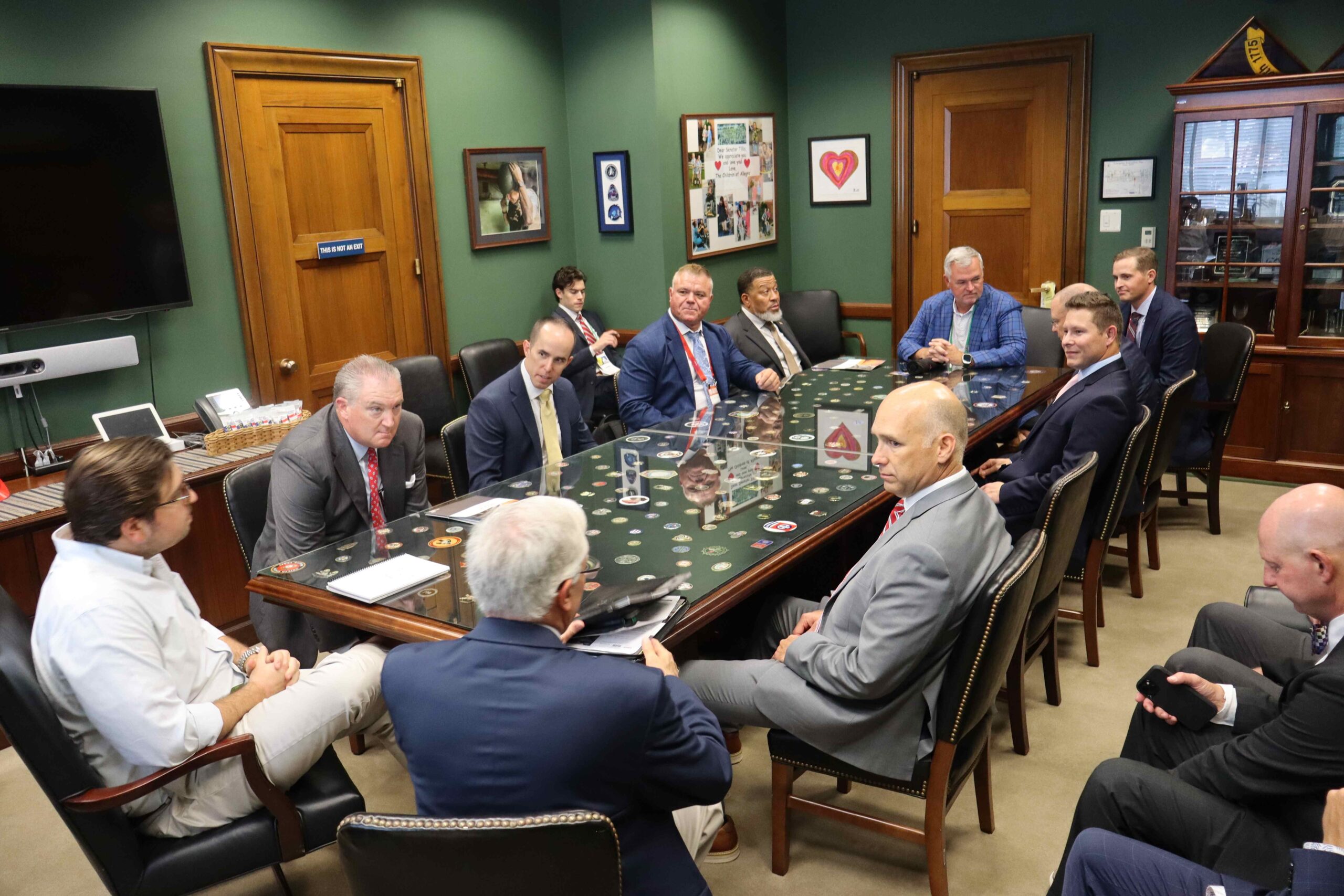
Highway Trust Fund (HTF) Solvency,
Tax Reform are Talk of the Hill
NAPA continued its part in advocating creative options to support the longevity of HTF, including finding ways to capture parts of the user market that do not pay into the system via the gas tax. Members were joined in Washington, D.C. in September by trade association counterparts that together presented one voice to legislators and staff on the need for certainty in infrastructure funding.
With the impending expiration of the Trump Tax Cuts, Hill Day attendees also were encouraged to share with lawmakers their concerns about the expiration of Section 199A Small Business Deductions and Bonus Depreciation. In meetings with members of Congress and their staff, NAPA members were joined by members from the National Stone, Sand & Gravel Association (NSSGA) and National Ready Mixed Concrete Association (NRMCA), in asking the federal government to consider industry feedback to secure the type of investment in infrastructure development that allows for a sustainable economy built for growth.
Secure the Highway Trust Fund to keep America moving
NAPA President & CEO Audrey Copeland penned an op-ed for the Washington Times in May that recognized the success of continued surface transportation funding made available by Congress, as well as the need to secure the future solvency of the Highway Trust Fund.
“In the past 25 years, we have missed the opportunity to create a long-term and sustainable solution to our exponentially growing infrastructure needs,” Copeland writes.
Low Embodied Carbon
Label Program
When the Environmental Protection Agency (EPA) released its Draft Criteria for Product Category Rules (PCR) to Support the Label Program for Low Embodied Carbon Construction Materials in March, NAPA’s Sustainability and PCR Committees developed a letter authored by Sustainable Pavements Director Joseph Shacat suggesting that the timelines put forth created a “moving target” that would be difficult to achieve. “Depending on the date that such datasets are finalized, program operators may have very little time to adopt these new datasets within the specified time frame,” Shacat wrote.
Resource Center Unifies Knowledge for Industry Guidance
NAPA debuted its new Resource Center as a replacement for its outdated online store. Free items across the digital library range from publications to webinar recordings. Use the search and filter functions to find exactly what you’re seeking. Once you find it, simply fill in the form and download. No purchase necessary!
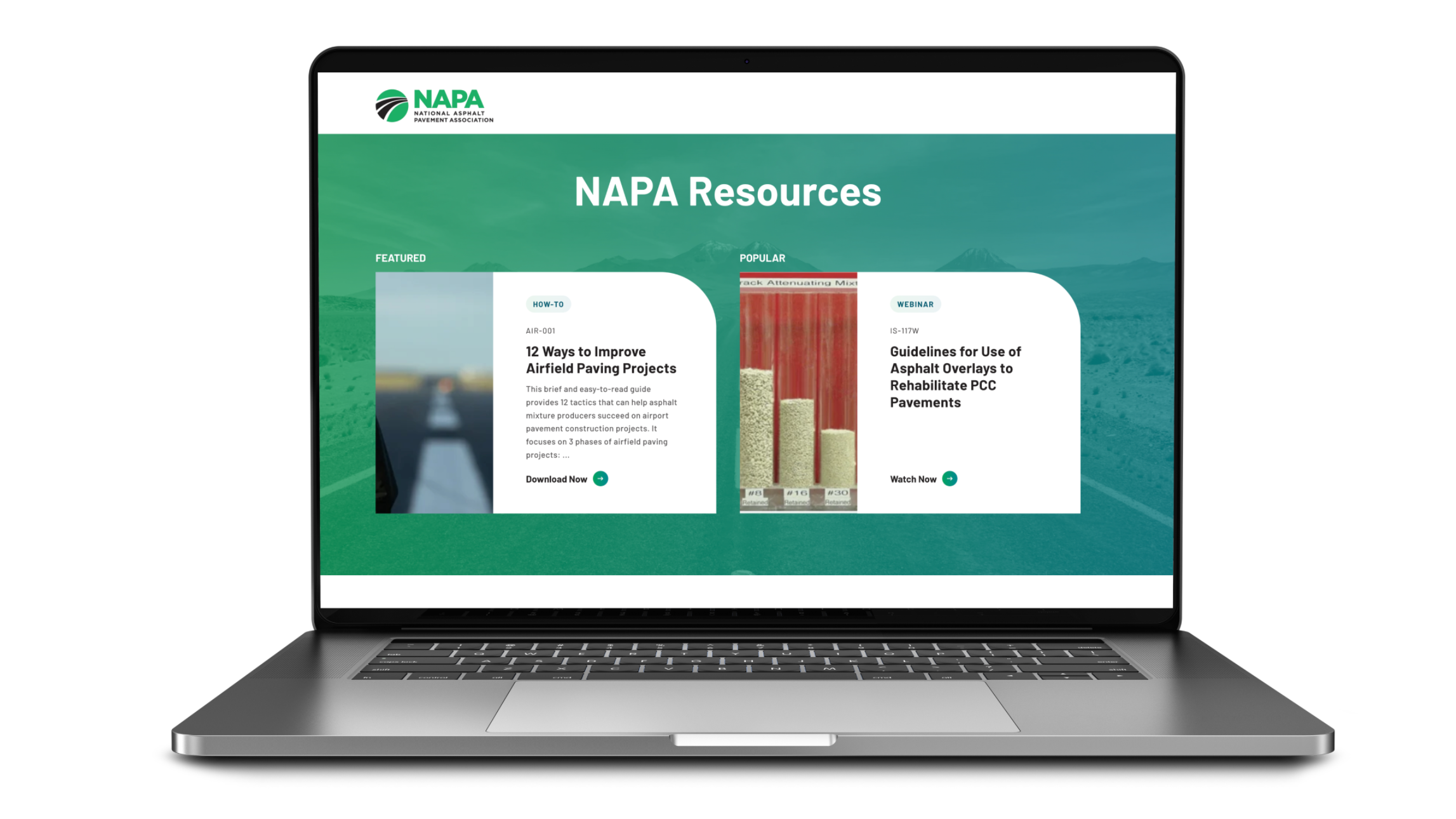
Visit Resource Center | NAPA
Putting Work Zone Safety in Focus
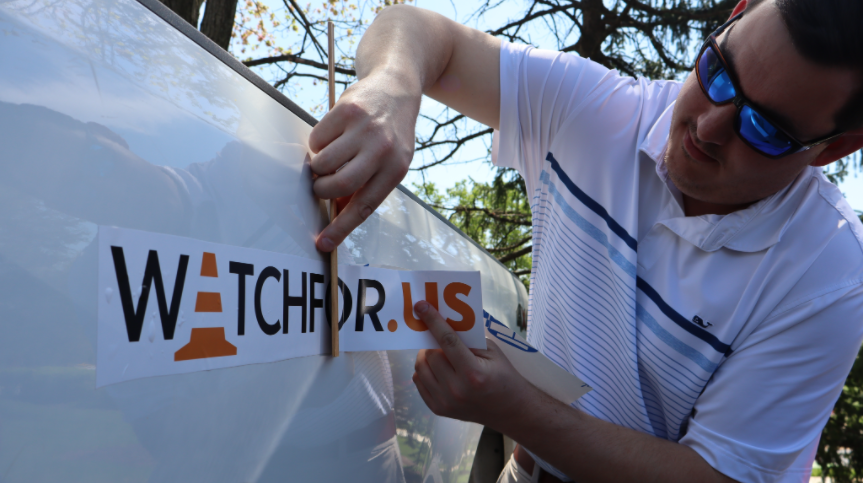
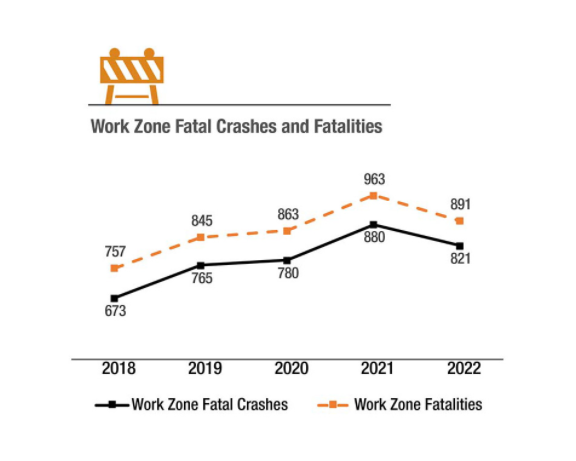
Putting Work Zone Safety in Focus
The Maryland Department of Transportation State Highway Administration hosted the 2024 kickoff event for National Work Zone Awareness Week (NWZAW) in a somber location not far from where a car entered a work zone and six roadside workers were lost the year prior. NAPA’s Audrey Copeland and Mitch Baldwin attended the event overlooking Interstate 695 in Woodlawn.
The event was a stark reminder of the annual toll of work zone fatalities, with the American Traffic Safety Services Association (ATSSA) Foundation displaying its National Work Zone Memorial which honors those lost in work zones to help policy makers and motorists see the real dangers roadside workers face each day. Throughout 2024, NAPA partnered with ATSSA to exchange messaging in each organization’s newsletters and magazines toward promoting work zone safety and awareness. The exchange lays the subgrade for future Watch For Us coalition development.
NAPA also took on the topic through a webinar focused on how companies can change work zone safety outcomes. NAPA Vice President for Environment, Health & Safety Howard Marks talked about the importance of work zone training.
“We know better DOT policies will help, but training and engaging your crews is really key, and there are a ton of training opportunities out there.”
NAPA’s CrewSafety: Work Zone Training is a free resource, which can augment state and local maintenance of traffic (MOT) and internal traffic control (ITC) plans.
NAPA letter to Sen. Braun (R-IN) on National Work Zone Awareness Week resolution (March 22, 2024)
Bookmark NAPA’s BMD Resource Guide for the latest updates
In July, NAPA published Impact of Laboratory RAP Preheating on Balanced Mix Design (BMD) Properties of Asphalt Mixtures. The research reveals the variations in RAP preheating methods among 39 state DOTs and 46 contractors, which can lead to differences in asphalt mixture properties. As the industry aims to use higher RAP percentages to enhance sustainability, optimizing preheating processes becomes crucial for ensuring consistent and reliable field performance of asphalt mixtures. 2024 also saw the creation of the Balanced Mix Design (BMD) Implementation Working Group.
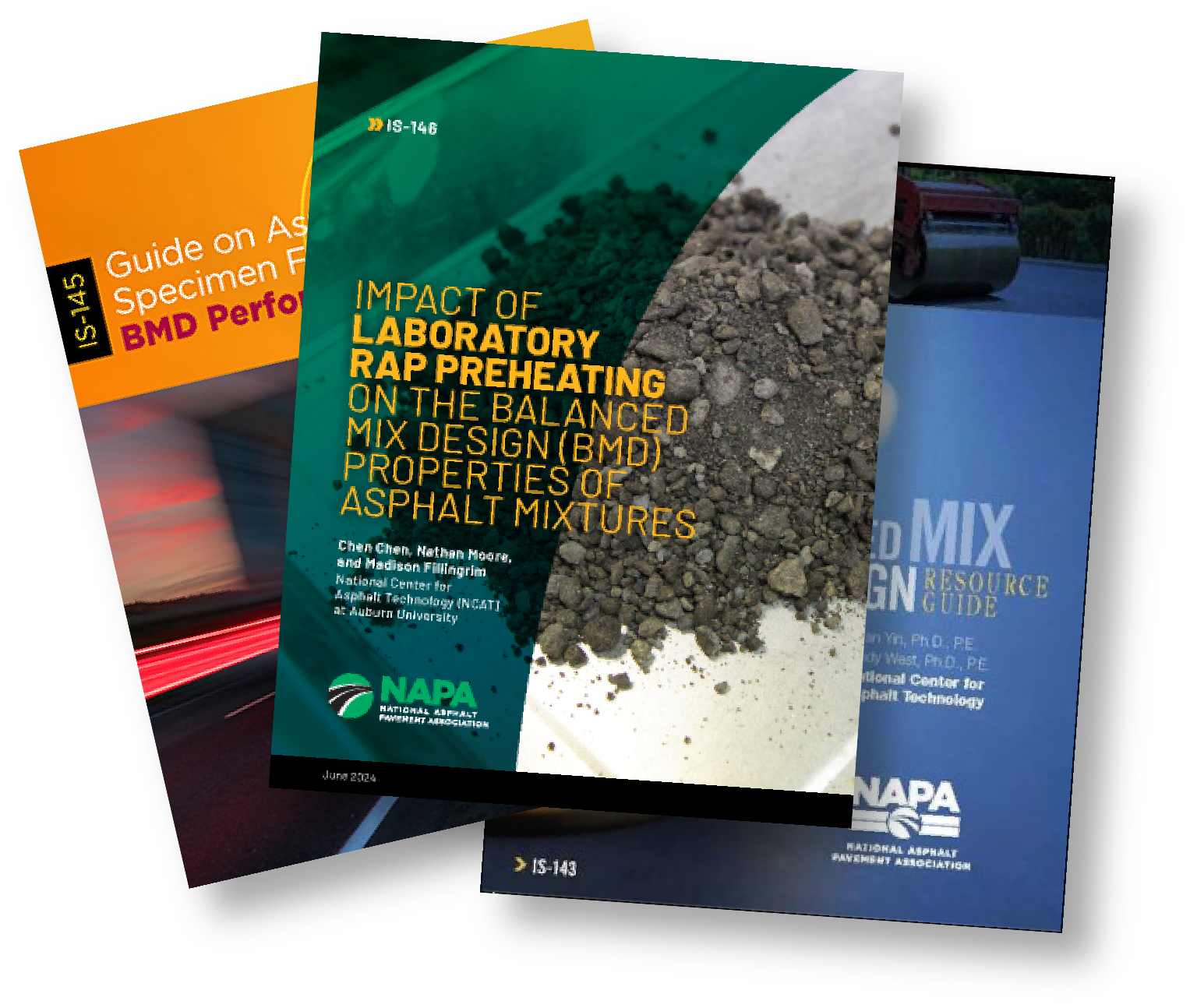
New OSHA Standard Highlights Importance of NAPA’s Heat Illness Prevention Plan

When the Occupational Safety and Health Administration (OSHA) released its long-awaited guidance on heat illness prevention standards, NAPA’s resources proved to be a guide for getting started on compliance.
NAPA Midyear Speaker Examines the Developing Workforce
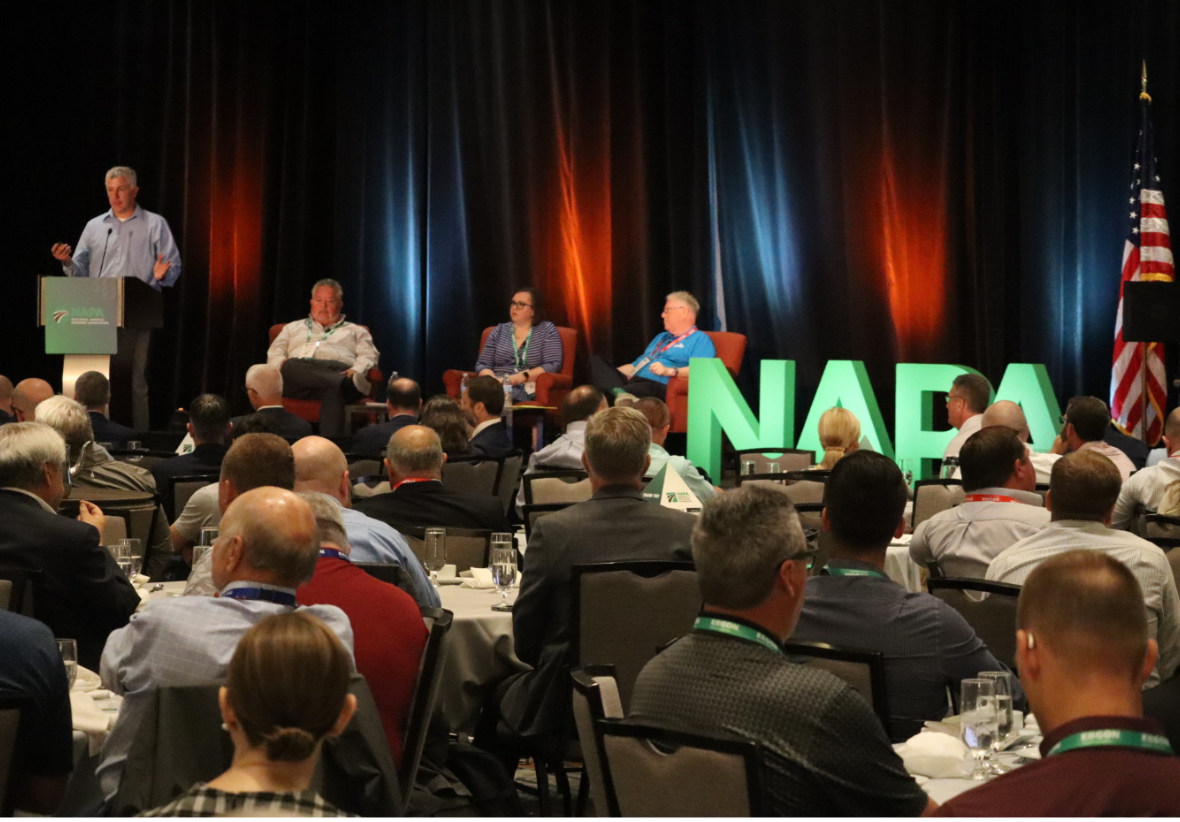
Solutions 21 CEO & Founder Buddy Hobart shared his insights from 15 years of research on leadership across generations during the opening general session of the NAPA 2024 Midyear Meeting in Brooklyn, NY, July 21-24. He said Millennials and Generation Z workers are looking for careers where there is an opportunity for advancement and a connection to sustainability, adding that he saw asphalt’s spot as the most recycled product in the country as a major recruitment angle.


